Overview Starbucks opened its first coffee bean store in Seattle's Pike Place Market in 1970.1 In 1982 the company hired 29-year-old Howard Schultz, a successful specialty coffee salesperson, as director of retail sales and marketing. Schultz wanted to make a difference in the specialty coffee industry. Fair-trade coffee had been around since the 1940s, providing coffee growers a fairer and higher price and better working conditions in developing nations. Shultz's idea was to turn Starbucks stores into community gathering places in the United States that deepen human connections over a cup of coffee. The Starbucks board rejected Schultz's idea, and he left the company in 1984 to initiate his own store, Il Giornale. Two years later, Schultz bought the six existing Starbucks stores for $3.8 million and merged them with his own store. This case is about how Schultz turned Starbucks stores into community hubs. The stores encouraged customers, even nonpurchasing ones, to embrace community issues, particularly diversity and economic development, and employee compassion for racial, ethnic, and other social issues that demanded attention. How Starbucks responded to a diversity crisis in its Philadelphia store in 2018 is examined in detail for lessons learned. Community Involvement Background Howard Schultz, age 33 when be bought Starbucks from the original owners, rejected the food and coffee franchise model in favor of Starbucks' direct ownership of all its stores. This involved standardizing some practices and leaving other policies to be locally determined. Schultz encouraged local hiring to reflect the local community. One of Shultz's first socially responsible policy changes was to extend full health benefits to eligible full- and part-time employees, as well as domestic partnership coverage. Schultz grew the business immediately, from six stores in 1986 to 30 stores in 1990 to 53 in 1992, the year Shultz took the company public and raised $271 million.2 His executive team developed a mission statement by which to guide its innovative operating decisions. The mission statement has evolved into this: "To inspire and nurture the human spirit one person, one cup and on neighborhood at a time."3 This is supported by Starbucks' core values: A culture that welcomes everyone Courageously challenge social and political issues Innovation and growth Integrity Accountability and responsibility to do the very best for all people Starbucks was among the first organizations in the 1990s to take climate change seriously by developing an environmental mission statement. The statement begins with the need to integrate concern for the environment in all aspects of operations and highlights the interrelationship between profits and environmental performance.4 This is achieved through transparency with partners; innovating solutions to foster change; only buying, selling, and using environmentally friendly products; promotion of fiscal responsibility; enforcing environmental responsibility as a core value; assessing metrics of projects; and motivating partners to share in the environmentally focused mission. Schultz wanted high integration between Starbucks stores and the local neighborhood. To that end, he instituted a hybrid form of philanthropy targeted to community nonprofits and job training programs in two underserved and low-income neighborhoods, one with a Magic Johnson Urban Coffee Opportunities store in Los Angeles and the other a Black Partner Network store in Harlem, New York. Starbucks shared its vast business knowledge and job training expertise with the nonprofits. These community projects were funded by the Shultz Family Foundation established in 1996. In 1999, the stores reopened, "redesigned to reflect and embrace the individual culture, character and needs of each of these neighborhoods, represent a new business model, bringing together the scale of Starbucks, its partners and customers to collectively create positive change in these communities."5 C
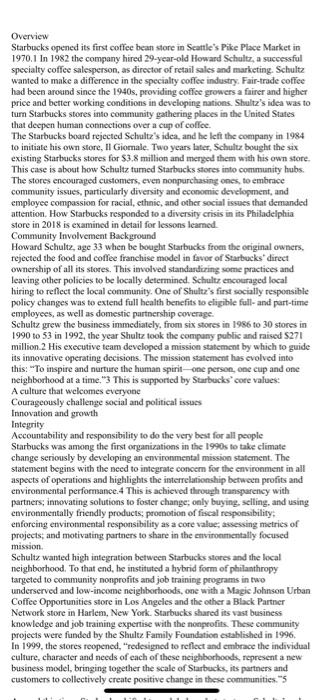
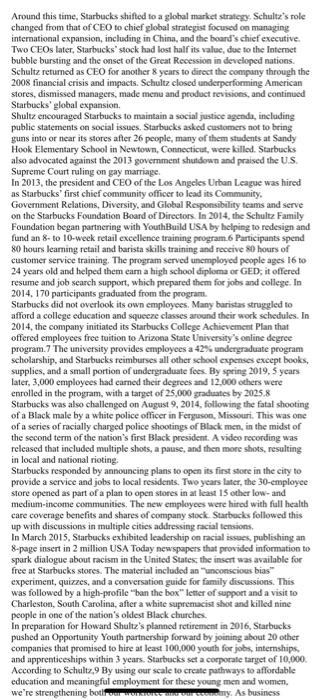
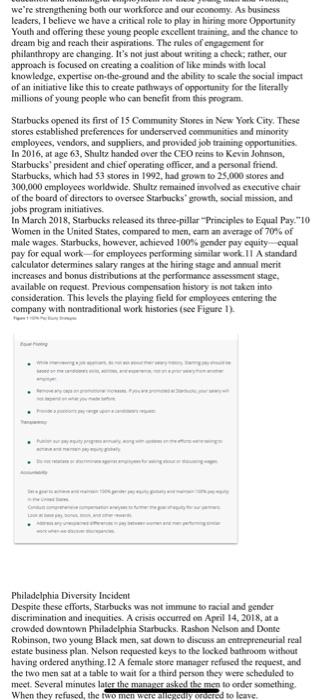
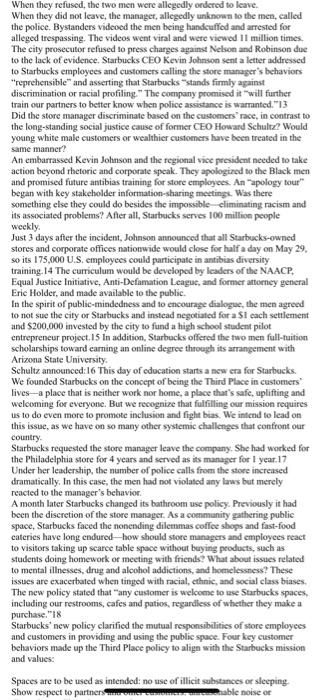
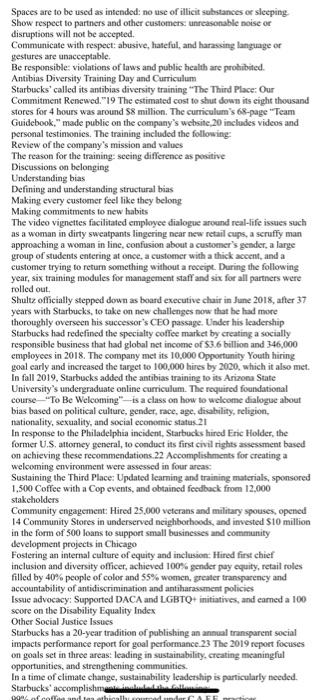

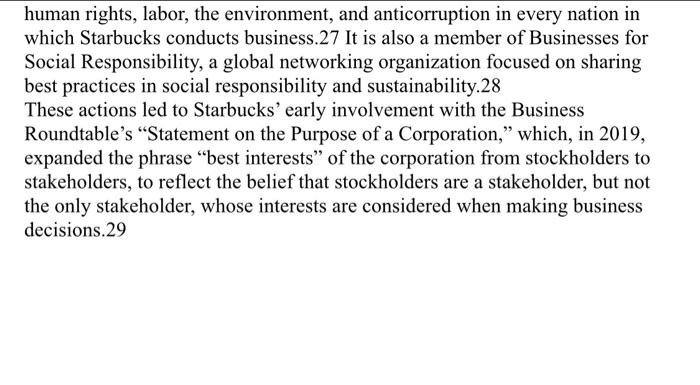
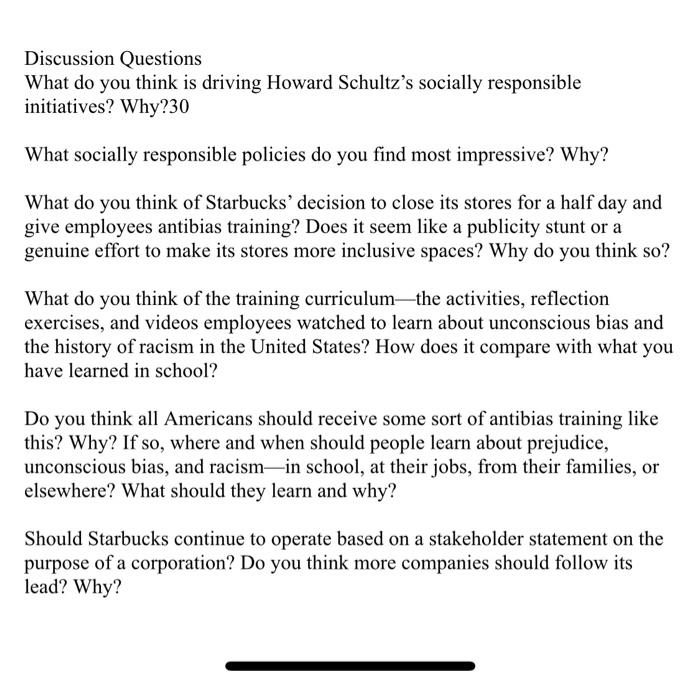
Overview Starbucks opened its first coffee bean store in Seartle's Pike Place Market in 1970.I In 1982 the company hired 29 -year-old Howard Schultz, a successful specialty coffee salesperson, as director of retail sales and marketing. Schultz wanted to make a difference in the specialty coffee industry. Fair-trade coffee had been around since the 1940 s, providing coffse growers a fairer and higher price and better working conditions in developing nations. Shultz's idea was to turn Starbucks stores into community gathering places in the United States that deepen human connections over a cup of coffoc. The Starbucks board rejected Sehult' 's idea, and be left the company in 1984 to initiate his own store, II Giomale. Two years later, Schultz bought the six existing Starbucks stores for $3.8 million and merged them with his own store. This case is about bow Schultz tumed Starbucks stores into community hubs. The stores encouraged customers, even nonpurchasing ones, to embrace community issues, particularly diversity and economic development, and employee compassion for racial, ethnic, and other social issues that demanded attention. How Starbucks responded to a diversity crisis in its. Philadelphia store in 2018 is examined in detail for lessons leamed. Community Involvement Background Howard Schultz, age 33 when be bought Starbucks froen the eriginal owners, rejected the food and coffee franchise model in favor of Starbucks' direct ownership of all its stores. This involved standardiring some practices and leaving other policies to be locally determined. Schultz encouraged local hiring to reflect the local community. One of Shultz's first socially responsible policy changes was to extend full bealth benefits to eligible full- and part-time employees, as well as domestic partnership coverage. Schultz grew the business immediately, from six stores in 1986 to 30 stores in 1990 to 53 in 1992, the year Shultz took the compuny public and raised $271 million.2 His executive team developed a mission statement by which to guide its innovative operating decisions. The mission statement has evolved into this: "To inspire and nurture the human spirit - one person, one cup and one neighborhood at a time,"3 This is supported by Starbucks' core values: A culture that welcomes everyone Courageously challenge social and political issues Innovation and growth Integrity Accountability and responsibility to do the very best for all people Starbucks was among the first organizations in the 1990 s to take climate change seriously by developing an environmental mission statement. The statement begins with the need to integrate coneem for the environment in all aspects of operations and highlights the interrelationship between profits and environmental performance.4 This is achieved through transparency with partners; innovating solutions to foster change; only buying, selling, and using environmentally friendly products; promotion of fiscal responsibility; enforcing environmental responsibility as a core value, assessing metrics of projects, and motivating partners to share in the environmentally focused mission. Schultz wanted high integration between Starbucks stores and the local neighborhood. To that end, he instituted a hybrid form of philanthropy targeted to community nonprofits and job training programs in two underserved and low-income neighborhoods, one with a Magic Johnson Urban Coffee Opportunities store in Los Angeles and the other a Black Partner Network store in Harlem, New York. Starbucks shared its vast business knowledge and job training expertise with the nonprofits. These community projects were funded by the Shulez Family Foundation cxablished in 1996. In 1999 , the stores reopened, "redesigned to reflect and embrace the individual culture, character and needs of each of these neighborhoodk, represent a new business model, bringing together the scale of Starbucks, its parthers and customers to collectively create positive change in these communities. -5 Around this time, Starbucks sthifted to a global market strategy, Schultz's role changed from that of CEO to chief global strateyist focused on managing international expansion, including in China, and the board's chief executive. Two CEOs later, Starbucks' stock had lost half its value, due to the Internet bubble bursting and the onset of the Great Reeession in developed nations. Schultz retumed as CEO for another 8 years to direct the compuny through the 2008 financial crisis and impacts. Schultz closed underperforming American stores, dismissed managers, made menu and product revisioes, and continued Starbucks' global expansion. Shultz encouraged Starbucks to maintain a social justice agende, including public statements on social issues, Starbucks asked customers not to bring guns into or near its stores after 26 people, many of them students at Sandy Hook Elementary School in Newtown, Connecticut, were killed. Starbucks also advocated against the 2013 govermment shutiown and praised the U.S. Supreme Court ruling on gay marriage. In 2013, the president and CEO of the Los Angeles Urban League was hired as Starbucks' first chicf community officer to lead its Community, Government Relations, Diversity, and Global Responsibility teams and serve on the Starbucks Foundation Board of Directors. In 2014, the Sehultz Family Foundation began partncring with YouthBuild USA by belping to redesign and fund an 8- to 10-week retail cxcellence training program. 6 Participants spend 80 hours learning retail and barista skills training and receive 80 hours of customer service training. The program served unemployed people ages 16 to 24 years old and helped them earn a high school diploma or GED; it offered resume and job search support, which prepared them for jobs and college. In 2014, 170 participants graduated from the program. Starbucks did not overlook its own employees. Many buristas struggled to afford a college education and squeere classes around their work schedules. In 2014, the company initiated its Starbucks College Achievement Plan that offered employees free taition to Arizona State University's online degree program. 7 The university provides employees a 42% undergraduate program scholarship, and Starbucks reimburses all other sehool expenses except books, supplies, and a small portion of undergraduate fees. Hy spring 2019,5 years later, 3,000 employees had earned their degrees and 12,000 ethers were enrolled in the program, with a target of 25,000 graduates by 2025.8 Starbucks was also challenged on August 9, 2014, following the fatal shooting of a Black male by a white police officer in Feryuson, Misvour.. This was one of a series of racially charged police shootings of Black men, in the midst of the second term of the nation's first Black president. A video recording was released that included multiple shots, a pause, and then more shots, resulting in local and national rioting. Starbucks responded by announcing plans to open its first store in the city to provide a serviee and jobs to local residents. Two years later, the 30 -employee store opened as part of a plan to open stores in at least 15 ether low-and medrum-income communities. The new employees were hired with full heatth care coverage benefits and shares of company stock. Starbocks followed this up with discussions in multiple citics addressing racial tensions, In March 2015, Starbucks exhibited leadership on racial issues, publishing an 8-page insert in 2 million USA Today newspapers that provided information to spark dialogue about racism in the United States the insert was available for free at Starbucks stores. The material included an "unconscious bias" experiment, quizzes, and a conversation guide for family discussions. This was followed by a high-profile "ban the box" lemer of support and a visit to Charleston, South Carolina, after a whine supremacist shot and killed nine people in one of the nation's oldest Black ctrurches. In preparation for Howand Shultz's planned retirement in 2016, Starbucks pushed an Opportunity Youth partnership forward by joining about 20 other companies that promised to hire at least 100,000 youth for jobs, internships, and apprenticeships within 3 years. Starbucks set a corporate target of 10,000 . According to Schultz, 9 By using our scale to create pathways to affordable education and meaningful employment for these young men and women. we're strengthening both our workforce and our economy. As business leaders, I believe we have a critical role to play in hining more Opportunity Youth and offering these young people excellent training, and the chance to dream big and reach their aspirations. The rules of eneagement for philanthropy are changing. It's not just about writing a check, nather, our approach is focused on creating a coalition of like minds with local knowledge, expertise on-the-ground and the ability to scale the social impact of an initiative like this to create pathways of opportunity for the literally millions of young people who can benefit from this program. Starbucks opened its first of 15 Community Stores in New York Ciry. These stores established preferences for undenserved communities and minority employees, vendors, and suppliers, and provided job training opportunities. In 2016, at age 63, Shultz handed over the CEO reins to Kevin Johnson, Starbucks' president and chief operating officer, and a personal friend. Starbucks, which had 53 stores in 1992 , had grown to 25,000 stores and 300,000 employees woridwide, Shultz remained involved as executive chair of the board of directors to oversee Starbacks' growth, social mission, and jobs program initiatives. In March 2018, Starbucks released its three-pillar "Principles to Equal Pay."10 Women in the United States, compared to men, earm an average of 70% of male wages, Starbucks, however, achieved 100 \% jender puy equity-equal pay for equal work-for employees performing similar woek: II A standard calculator determines salary ranges at the hiring stage and annual merit increases and bonus distributions at the performance assessment stage. available on request. Previous compensation history is not taken into consideration. This levels the playing field for employees entering the company with nontraditional work histories (see Figure 1). * Philadelphia Diversity Incident Despite these efforts, Starbucks was not immune to racial and gender discrimination and inequities. A crisis occurred on April 14, 2018, at a crowded downtown Philadelphia Starbucks. Rashon Nelson and Donte Robinson, two young Black men, sat down to discuss an entrepreneurial real estate business plan. Nelson requested keys to the locked bathroom witheut having ordered anything. 12A female store manager refused the request, and the two men sat at a table to wait for a thind person they were seheduled to meet. Several minuses later the manaser asked the men to order something. When they refused, the two men were alc y orucred to leave. When they refused, the two men were allegedly ordered to leave. When they did not leave, the managet, allegedly unknown to the men, called the police. Bystanders videoed the men being handeuffed and arrested for alleged trespassing. The videos went viral and were viewed 11 million times. The city prosecutor refused lo press charges against Nelwon and Robinson due to the lack of evidence. Starbucks CEO Kevin Johnson sent a letter addressed to Starbucks employees and customers calling the store manager's behaviors "reprehensible" and asserting that Starbucks "stands firmly against discrimisation or racial profiling." The coenpany promised it "will further train our partners to better know when police assistance is warranted."13 Did the store manager discriminate based on the customers' race, in contrast to the long-standing social justice cause of former CEO Howard Schulrz? Would young white male customers or wealthier customers have been treated in the same manner? An embarrassed Kevin Johnson and the regional wice president needed to take action beyond rhetoric and corporate speak. They apologined to the Black men and promised future antibias training for store cmployees An "apology tour" began with key stakeholder information-sharing meetinge. Was there something else they could do besides the impossible-eliminating racism and its associated problems? After all, Starbucks serves 100 million people weekly. Just 3 days after the incident, Johnson announced that all Starbucks-owned stores and corporate offices nationwide would close for half a day on May 29. 50 its 175,000 U.S. employees could participate in antibias diversity training. 14 The curriculum would be developod by leaders of the NAACP. Equal Justice Initiative, Anti-Defamation League, and former amtomey gencral Eric Holder, and made available to the public. In the spirit of public-mindedness and to encourage dialogue, the men agreed to not sue the city or Starbucks and instead negoeiated for a $1 each settlement and $200,000 invested by the city to fund a high school student pilot entrepreneur project. 15 In addition, Starbucks offered the two men full-tuition scholarships toward earning an online degree through its arrangement with Arizona State University: Schultz annoumced:16 This day of education starts a new era for Starbecks. We founded Starbucks on the concept of being the Third Place in customers' lives-a place that is neither work nor home, a place that's safe, uplifting and welcorming for everyone. But we recognize that fulfilling our mission requires us to do even more to promote inclusion and fight bias. We intend to lead on this issue, as we have on so many other systemic challenges that confront our country. Starbucks requested the store manager leave the company. She had worked for the Philadelphia store for 4 years and served as its manager for 1 year. 17 Under ber leadership, the number of police calls from the stoee increased dramatically, In this case, the men had not violated any laws but merely reacted to the manager's behavior. A month later Starbucks changed its bathroom use policy. Previously it had been the discretion of the store manager. As a commanity gathering public space, Starbucks faced the nonending dilenmas coffee shops and fast-food cateries have long endured - how should store managers and employees react to visitors taking up scarce table space without buying products, such as students doing homework or meeting with friends? What about issues related to mental illnesses, drug and alcohol addictions, and homelessness? These issues are exacerbated when tinged with racial, ethnic, and social class biases. The new policy stated that "any customer is welcome to use Starbucks spaces, including our restrooms, cafes and patios, regardless of whether they make a purchase, "18 Starbucks' new policy clarified the mutual responsibilities of store employes and customers in providing and using the public spuce. Four key customer behaviors made up the Third Place policy to align with the Starbecks mission and values: Spaces are to be used as intended: no wse of illicit substances or sleeping Show respect to parthers Spaces are to be used as intended: no use of illicit substances or sleeping Show respect to partners and other customers: unreasonable noise or disruptions will not be aceepted. Communicate with respect: abusive, hateful, and harassing language or gestures are unaceeptable. Be responsible: violations of laws and public health are prokibited. Antibias Diversity Training Day and Curriculum Starbucks' called its antibias diversity training "The Thind Place: Our Commitment Renewed."19 The estimated cost to shut down its eight thousand stores for 4 bours was around 58 million. The curriculum's 68-page "Team Guidebook," made public on the company's website, 20 includes videos and personal testinonies. The training included the following: Review of the company's mission and values The teason for the training: seeing difference as positive Discussions on belonging Understanding bias Defining and understanding structural bias Making every customer feel like they belong Making commitments to new habits The video vignettes facilitated employee dialogue around real-life issues such as a woman in dirty sweatpants lingering near new retail cups, a scruffy man approaching a woman in line, confusion about a customer's gender, a large group of students entering at once, a customer with a thick aceent, and a customer trying to return something without a receipt. During the following year, six training modules for management staff and six for all partners were rolled out. Shultz officially stepped down as board executive chair in June 2018, after 37 years with Starbucks, to take on new challenges now that he had more thoroughly overseen bis suceessor's CEO passage. Under his leadership Starbucks had redefined the specialty coffee market by creating a socially responsible besiness that had global net income of $3.6 billion and 346,000 employees in 2018. The company met its 10,000 Opportunity Youth hiring goal early and increased the target to 100,000 hires by 2020 , which it also met. In fall 2019, Starbucks added the antibias training to its Arizona State University's undergraduate online curriculum. The roquired foundational course "To Be Weleoming"- is a class on how to welcome dialogue about bias based on political culture, gender, race, age, disability, religion. nationality, sexuality, and social economic status 21 In response to the Philadelphia incident, Starbucks hired Eric Holder, the former U.S, attorncy general, to conduct its first civil rights assessment based on achieving these recommendations. 22 Accomplishments for creating a welcoming environment were assessed in four areas: Sustaining the Third Place: Updated learning and training muterials, sponsored 1,500 Coffee with a Cop events, and obtained feedback from 12,000 stakeholders Community engagement: Hired 25,000 veterans and military spouses, opened 14 Community Stores in underserved neighborhoods, and invested $10 million in the form of 500 loans to suppont small businesses and community development projects in Chicago Fostering an internal culture of equity and inclusion: Hired first chief inclusion and diversity officer, achieved 100% gender pay equity, retail roles filled by 40% people of color and 55% women, greater transparency and accountability of antidiscrimination and antiharasument policics Issue advocacy: Supported DACA and LGBTQ+ initiatives, and earned a 100 seore on the Disability Equality Index Other Social hustice Issues Starbucks has a 20-year tradition of pablishing an annual transparent social impacts performance report for goal performance. 23 The 2019 report focuses on goals set in three areas: leading in sustainability, creating meaningful opportunities, and strengthening communities. In a time of climate change, sustainability leadership is particularly needed. Starbucks' accomplishm In a time of climate change, sustainability leadetship is particularfy needcd. Starbucks' accomplishments included the following: 99% of coffee and tea ethically sourced under C.A.F.E. practices 40 million trees distributed since 2015 to Latin American coffee farmers Trained 88,000 farmers in 2019 12 major cities recycling Starbucks cups More than 105 million disposable cups saved by customers, which doesn't include China, by bringing their own cup or using a ceramic mug offered in store Replaced single-use plastic straws with sustainable-material straws and a straw-free new cup design Built more than 1,600 L.EDD-ertified stores around the world 26,000 employees enrolled in the Greener Apron sustainability training program through Starbacks Giobal Academy 72% of global operations powered by renewable energy All of these sentiments are encapsalated downstream by Starbucks" "Code of Conduct for Suppliers," which ensures that production inputs are ethically sourced. Starbucks' suppliers must sign a code of conduct pledging to24 demonstrate conmmitment to the welfare, econonic improvement, and sustainability of the people and places that produce Starbucks" products and services: adhere to local laws and international standards regarding human rights, workplace safety, and worker compensation and treatment; meet or exceed national laws and international standards for ervironmental protection; commit to measuring, monitoring, reporting, and verifying compliance; and pursue continuous injprovement of these social and environmental principles. Starbucks' environmental mission statement, adopted way back in 1992, paved the way for Starbucks' quick adoption of a scicnce-bused company program based on achieving 2015 Paris Agreement targets. 25 The major targets include limiting a company's carbon emissions and global warming impacts to 15C above preindustrial levels. The unexpected depeh of the Covid-19 pandemic challenged Starbucks to act on its values even further. Originating in China in December 2019 , the coronavirus took root in markets across the world as local, state, and national governments struggled to limit its spread, slowly trying to balance individual safety with economic well-being. One's positioe on economic restrictions in terms of stores opening and customer service limits fell along party lines, with Republicans eruphasizing keeping the economy open while Democrats emphasized individual safety. The first American deaths occurned in February 2020 , and by the end of 2020 more than 300.000 had died, among the 16.6 million who tested positive. The virus was primarily passed among people attending large-seale gatherings. Starbucks took Covid-19 initiatives early in the process to assure employees. they would not catch the virus by going to work and that customers would not eatch the vinus by visiting a store, 26 Efforts incladed mandating facial coverings and social distancing as determined by public health officials, taking employee temperatures at the beginning of every shift, and advanced cleaning and sanitizing protocols. Customers were served through grab-and-go techniques, prearranged curbside pickups, and store deliverics. After the magnitude of Covid-19 became better understood in March, employees were allowed to stay at home or earn catastrophe pay until May 31 , 2020 , and take a leave of absence through the second quarter of 2021 while still earning health abd daily food benefits. Support staft in Seatle were encouraged to work remotely, childeare services were expanded, and grants were made available to offset financial hardships. Multimillion dollar donations were made to local and national nonprofits and to support coffeegrowing communities. On a broader scale, Starbucks continues to demonstrate leadership in the social responsibility movement. The comapany signed its commitment to the United Nations Global Compact's 10 principles related to the treatment of human rights, labor, the eurerouncengenureminomposen in every nation in human rights, labor, the environment, and anticorruption in every nation in which Starbucks conducts business. 27 It is also a member of Businesses for Social Responsibility, a global networking organization focused on sharing best practices in social responsibility and sustainability. 28 These actions led to Starbucks' early involvement with the Business Roundtable's "Statement on the Purpose of a Corporation," which, in 2019, expanded the phrase "best interests" of the corporation from stockholders to stakeholders, to reflect the belief that stockholders are a stakeholder, but not the only stakeholder, whose interests are considered when making business decisions. 29 Discussion Questions What do you think is driving Howard Schultz's socially responsible initiatives? Why?30 What socially responsible policies do you find most impressive? Why? What do you think of Starbucks' decision to close its stores for a half day and give employees antibias training? Does it seem like a publicity stunt or a genuine effort to make its stores more inclusive spaces? Why do you think so? What do you think of the training curriculum - the activities, reflection exercises, and videos employees watched to learn about unconscious bias and the history of racism in the United States? How does it compare with what you have learned in school? Do you think all Americans should receive some sort of antibias training like this? Why? If so, where and when should people learn about prejudice, unconscious bias, and racism - in school, at their jobs, from their families, or elsewhere? What should they learn and why? Should Starbucks continue to operate based on a stakeholder statement on the purpose of a corporation? Do you think more companies should follow its lead? Why














